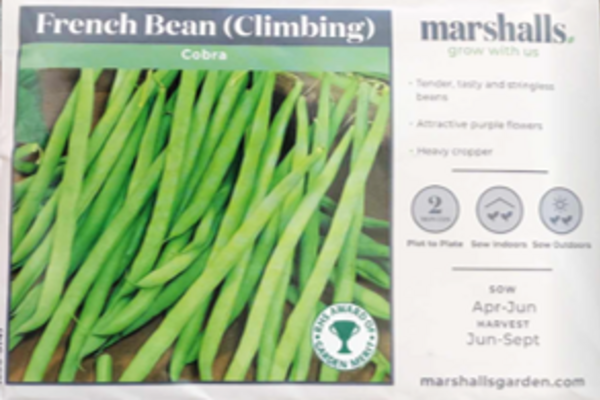
Cobra French beans are a popular choice for both home growers and competitive exhibitors due to their reliability, excellent flavour, and impressive yields. Whether you are growing them for the kitchen or aiming to impress at horticultural shows, following the right sowing, planting, and harvesting methods will help you achieve the best results.
Michael Burke, NVS member from Co. Dublin, has grown Cobra French beans previously and further to our members receiving a free packet of the Cobra French Bean with our Spring Magazine, courtesy of our Partner Marshalls, we are delighted that Michael is sharing his experience with us.
Sowing Seeds
For home use, I recommend sowing Cobra French bean seeds from the second week of April onwards in 4-inch pots. Use high-quality multi-purpose compost and plant the seeds one inch deep, covering them lightly before watering well. Be sure to label each pot to keep track of different sowing dates.
For those looking to enter horticultural shows, a staggered approach to sowing will ensure a steady supply of beans at the right stage for competitions. You can sow seeds in the last week of March, the second week of April, and the first week of May. This ensures you have beans ready for shows held in July, August, and early September. Since not all seeds may germinate or grow uniformly, I recommend sowing a few extra to allow for selecting the very best specimens.
Once the seedlings have developed their first true leaves and the risk of frost has passed, they can be hardened off before planting outdoors.
Planting
Choose a warm, sheltered location that is protected from strong winds and receives indirect sunlight. While Cobra French beans thrive in full sun, excessive exposure can sometimes stress young plants, so a slightly shaded area can be beneficial.
It is crucial to prepare the planting site well in advance. Ensure the soil is well-drained and rich in organic matter by incorporating well-rotted manure or garden compost a few weeks before planting. Just before transplanting, water the soil thoroughly to provide a moist, welcoming environment for the young plants.
For support, place 8-foot canes firmly in the ground, spacing them 9 inches apart. Secure them at the top by tying them to a horizontal cane to form a stable structure. Each plant should be positioned at the base of a cane, where it will naturally twine in an anti-clockwise direction as it grows.
Good air circulation is essential to prevent diseases, so avoid overcrowding. Once the pods begin to form, feed the plants weekly with a high-potash fertiliser such as tomato feed to encourage healthy pod development and an abundant harvest.
To improve pollination rates and boost bean production, plant nectar-rich flowers nearby to attract bees, which will help pollinate the bean blooms.
Harvesting
Most Cobra French beans will be ready to harvest around one to two weeks after the flowers appear. Pick the pods regularly to encourage further production, as leaving mature beans on the plant can slow down growth. Harvesting every few days ensures a continuous supply of tender, stringless beans.
For the best flavour and texture, pick the beans when they are smooth, firm, and around the thickness of a pencil. Overripe beans tend to develop a tough texture and become less desirable for culinary use.
Showing Cobra French Beans
For those entering competitions, careful selection of pods is essential. In National Vegetable Society (NVS) shows, Cobra beans are judged either as climbing or dwarf French beans, with a total of 15 points available. Judges assess the following key qualities:
• Condition (5 points) – Beans should be fresh, tender, and blemish-free.
• Size (2 points) – Pods should be of an appropriate and desirable length, typically uniform in size.
• Uniformity (3 points) – All beans in an entry should be of equal size and shape.
• Colour (2 points) – Beans should have a vibrant, healthy green colour.
• Beans not showing (3 points) – The seeds inside should not be visible or bulging through the pod.
To maximise your chances of success, select beans that are as straight as possible, with no signs of curling or twisting. Pick them fresh on the day of the show or as close to the show date as possible. Store them in a cool, damp cloth to maintain their appearance and condition.



